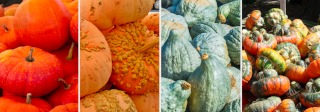By Ms. Mary Michaela Parker
Pumpkins, gourds, and squash, oh my! With fall in full effect, I’m buying fall décor all the time. Do I already have several pumpkins on my porch? Yes. Will I be buying more? Also, yes.
Fall produce purchased at your local pumpkin patch or gardening store can also double as cooking ingredients. (Who doesn’t love fall comfort foods?!) Pumpkins, gourds, and squash all are members of the Cucurbitaceae family and share several similar characteristics. When out browsing fall produce, pay attention for these varieties that are perfect for cooking!
- Cinderella Pumpkins: These pumpkins are sweet, rich tasting, and are delicious when cooked in desserts.
- Peanut Pumpkins: Don’t let the warts turn you off from using them in baked goods! The warts are excess sugars, perfect for baked goods.
- Hubbard Squash: This is a versatile fall produce. It’s sweet, golden, and tasty in both sweet and savory fall dishes.
- Turban Squash: This type of squash can be used in savory dishes and can be substituted for butternut or acorn squash in recipes.

L to R: Cinderella Pumpkins, Peanut Pumpkins, Hubbard Squash, Turban Squash (Photos by Canva and MSU Extension)
Don’t be fooled in thinking you can cook with any type of fall produce. Here are two to avoid eating:
- Jack-O-Lantern Pumpkins: This type of pumpkin is commonly used for carving. If you’ve ever carved a pumpkin, you are familiar with their stringy and watery texture. Because of that, they’re not great for cooking. The seeds on the other hand, can be roasted for a nice snack!
- Ornamental Gourds: You could technically eat a gourd, but it won’t be the easiest to work with or the tastiest treat out there. They have hard shells and don’t taste as great as the other fall produce. It’s best to only use gourds for décor.
Remember to never eat pumpkin after it has been carved. Once a pumpkin has been carved, it’s considered a potentially hazardous or perishable food! Ready more on why you shouldn’t eat carved pumpkins in this article from our friends at Michigan State University Extension.
Want some fun pumpkin recipes for this fall? Check out these Food Factor recipes for pumpkin spice lattes and crustless pumpkin pies.
Source : msstate.edu